by Christian Strohm
Vehicles are becoming more and more dependent upon computers every year. In fact, some repairs and services cannot even be done without the proper equipment to communicate with on-board computers. Your shop needs to be outfitted with the necessary tools and reference materials in order to get the job done. Here, we’ll explore some of the most useful gear for the independent shop that wants to take on the Asian repair market.
Engine management technology is naturally the first thing that comes to mind, and this has been changing at an incredible rate. Just because you were familiar with some of the Asian diagnostic and repair techniques of the 1990s doesn’t mean you’ll be able to survive the 21st century on that knowledge. Just take variable valve timing for example. Not only are manufacturers controlling cam timing and lift, on engines such as the Nissan VVEL the intake valves’ lift instead of a conventional throttle body to vary the cfm that enters the cylinders!
Let’s talk computers
In order to keep up with the newest automotive technologies, invest in a good computer and Internet connection. Get rid of that beat-up desktop and replace it with a high-quality, rugged laptop, and maybe consider one that has a touch screen so you can use a pen to navigate. Now, you have a mobile station that doesn’t have a touchpad or mouse that gets smeared with grease, and you can take it into the car or keep it on the bench for reference.
If you’ve got a laptop and a subscription to ALLDATA, you’re going to want to set up wireless internet access – don’t worry, I’ll spare you the technobabble! The only addition should be a wireless router that you can install somewhere near the work bays for a good, strong signal. Going wireless doesn’t necessarily mean more complicated, less reliable, slower, and more expensive. Just because you’re a business doesn’t mean you need an expensive, enterprise-class router. Check out an electronics retailer and search for some home-style routers. Home routers are easy to set up, and with IEEE 802.11 security standards, they’re quite secure. Follow industry standard practices for using a strong WPA code (avoid WEP at all costs!), and you could even impress your customers with WiFi in the waiting room. Microsoft has an article on setting up wireless, so visit this website for more information:
Collaboration
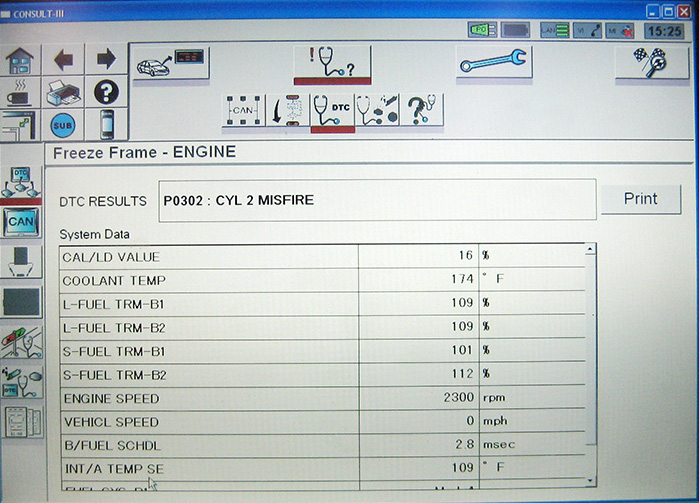
From the Freeze Frame Data screen on the Nissan CONSULT-III, you can see the advanced diagnostic work support buttons. With one press, you can perform a DTC check, access Bi-directional controls, monitor Live Data PIDs, check the CAN bus tree for faults, graph and record desired sensor outputs, along with anything a basic scan tool can perform.
Look into a subscription-based service like https://www.identifix.com that helps you find possible pattern problems with the cars you’re working on. This online tool is not unique to the Asian repair market, so your shop may already have Identifix. If you’re unfamiliar with it, the site allows its members to post confirmed fixes of various repairs, and helps you search by trouble code or symptom to find helpful tips. You get the benefit of other technicians’ prior experiences to shorten your diagnostic times. Especially if you’re new to the Asian repair industry, you can begin to research common failures in your off time. Direct Hit, an adjunct to Identifix, is another great source of silver bullets.
Be certain to look into the International Auto Technicians’ Network (iATN). This is an incredible resource for collaboration. Think of it as an automotive forum that has good information about whatever problem you may be struggling with at the shop. If you’re new to the Asian market, you can find loads of information about pattern failures and symptoms in the network. Register online at https://iatn.net.
It’s also critical to develop a good rapport with your local dealerships’ wholesale departments. If you keep a regular stock order with a dealership, you’re constantly in contact with their wholesale parts department, and they may start cutting you some slack if you need to return a part or maybe ask for tips from their service department. Consider stocking automakers’ O.E. specialty fluids. For instance, having an identifiable, colored factory fluid on hand makes your shop appear to specialize in that manufacturer’s cars when performing services. Many Japanese manufacturers use any color BUT green, so consider stocking Honda’s blue, Toyota’s Pink, Mazda’s orange and yellow, Subaru’s blue for their newest, and Nissan’s green. Are they all really different? That’s an entire different article, but remember that discerning customers will know that their cars used to have a certain color fluid. So, don’t lose out on long-term customers by using generic antifreeze in everything.

Using a factory fluid for its intended application is one aspect of specialization. Mazda has three different colors and mixtures! Does it make sense for your shop to stock all of them? From Left to Right: Mazda Gold, Mazda Green, Mazda Orange.
Specialization
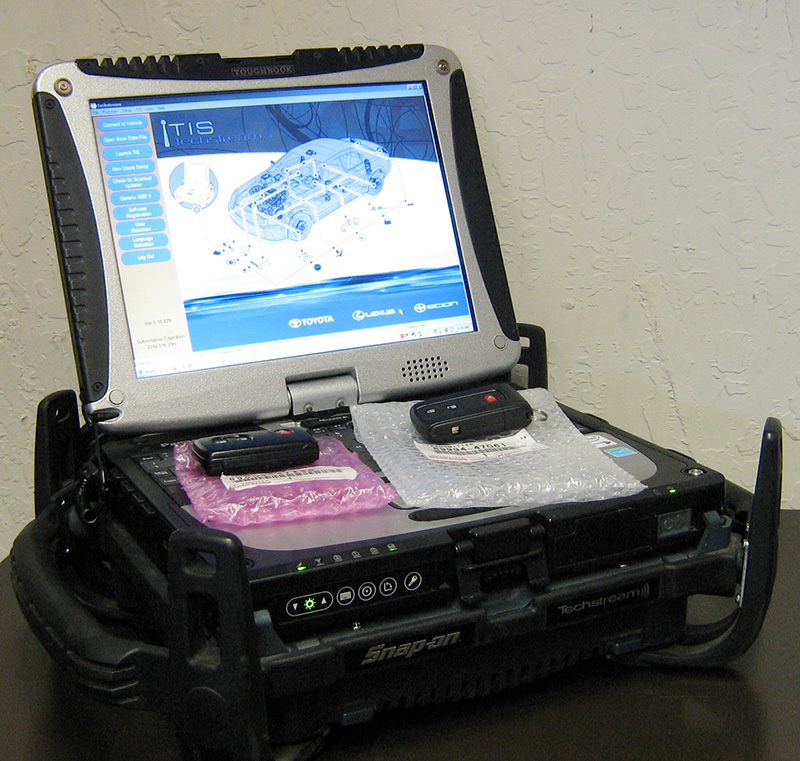
The Toyota Techstream is required to program the 2nd Generation Prius Smart Key (right), and the 2010-2012 Prius key (left). It is also required for performing brake flushes on some vehicles, as well as other services.
Factory service tools may seem expensive, but without them you cannot complete certain repairs, or you’ll spend extra hours “making do†with alternative methods. This section should help you explore whether it is necessary to invest in a particular factory service tool. Being able to offer the same services that a dealership offers – short of warranty repairs – is a good marketing opportunity, as well as a way to grow. Only you can determine how much to actually invest in special, factory equipment for servicing the most common Asian auto makers. If you plan to start working on Toyota, Honda, Mazda, Subaru and Nissan, does it make sense to get every special computer and online subscription? Read on to find out more about what might work best for your shop.
The most important factory tools for modern cars are the factory scan tool and a subscription to the manufacturer’s technical website — most call their online subscription some form of “Techinfo.†Without the scan tool, it will be impossible to perform certain “simple†service tasks on modern cars in a factory-approved method. PCM programming and certain security features like immobilizer key systems will also require a subscription to repair. If you want to do the job right, you will have to invest in the correct tools.
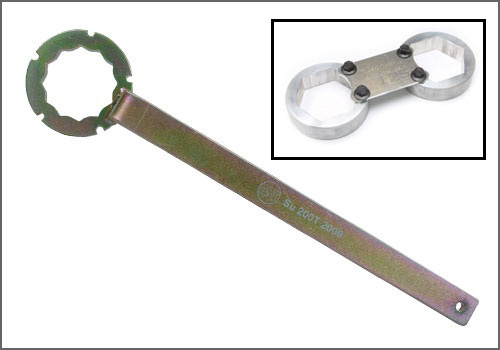
You won’t have to fear bending a valve or chipping the plastic sprocket on a Subaru if you’re using this SST# 499207300. Invest in specialty tools to increase your shop’s efficiency.
Other specialty tools are important, but only if you plan to do specific repairs repeatedly. For example, the Subaru cam sprocket holder is necessary for replacing the head gaskets efficiently. It will also allow you to more easily remove the cam sprockets to service the cam oil seals. Considering the sheer number of failures in Subaru head gaskets, this particular tool is a great way to avoid chipping the plastic cam gears when trying to hold them using incorrect tools. Each manufacturer will have a special service tool (SST) distributor company. In this instance, contact SPX for Subaru tools at  .
If you’re on a tight budget, Techinfo sites have options for purchasing a “guest pass†that will allow you access without having to subscribe for an entire year (you can add the charge to the customer’s bill), Consider “test driving” the factory Techinfo pages to see if they will be necessary to your shop. These sites will have updated TSB or recall information that even good sites like ALLDATA don’t have. The service manuals on the Techinfo sites will often allow quick hyperlink navigation from one repair to another, or from the diagnostic tree to the appropriate fix.
More computers? What’s so special about the factory scan tools?
Why should you even consider a factory tool or information system when you already have something that seems to be good enough? Again, it depends upon what type of Asian repair work you plan to be doing. Here are a few examples of simple services you may not be able to do without the factory scan tool:
- The Toyota Prius brake fluid flush requires a scan tool that has bi-directional controls — the brake pedal is not physically connected to a master cylinder! The pedal sends a request to a computer that calculates whether or not the service brakes need to be applied, or if regen will be enough. Without the tool, you’re just pushing on a pedal attached to a sensor, not bleeding any fluid.
- Honda’s 2005 and newer maintenance reminder system requires the factory scan tool to clear history of service items that were completed, but not displayed on the dash. For example, if you sell your customer transmission fluid service, but the minder only displayed “A1,†without properly clearing the reminder, the customer may get a minder item “3†for transmission fluid service shortly after he leaves. It makes you appear unprofessional, and it may even cause the customer to begin to doubt whether you did what you said you did. When you clear the indicator without the scan tool, it only resets whatever is currently displayed.
- Modern cars have proprietary information codes associated with the OBD II- compliant DTCs. For example, your generic scan tool may display a Prius with fault P3120. In fact, many generic scanners won’t display the P3XXX codes at all! Not only will you have to look up what the “plain English†translation of this code means using the repair manual, you won’t have a critical information code. P3120 is listed as “HV transaxle malfunction” – how useless is that? You’ll have to spend more energy on research and diagnosis, but if you had the TechStream to output the information code 250, and a subscription to the Toyota Information System (TIS), you can cut to the chase: “If information code 248 or 250 is output, replace HV transaxle motor.” There is no other diagnostic procedure.
- OBD II compliance does not require that a manufacturer make every on-board computer fault accessible with generic scan tools. We see a lot of vehicles come into our shop without the MIL on, but the owners are complaining about a symptom. With the Nissan CONSULT, we can access the body ECU and find faults associated with the HVAC or headlight control on a 2008 Infiniti EX35, for example. You can eliminate tremendous amounts of time spent following step-by-step testing when you short circuit the process with a factory scan tool.
There are many more instances where you cannot complete a repair without a factory scan tool. Modern transmissions that are CVT style, or do not have a fill tube must be operated and drained using the scan tool for operating temperature monitoring. Does your customer want to buy a new Smart Key for her Prius, or does her husband’s Mazda need an immobilizer RFID key programmed? If you’ve done all the other work on those cars up to this point, do you really want to send them to the dealership? Referral to the dealership will start your customers thinking that your shop is not equipped to handle difficult problems.
Consult this table to find the names of the factory scan tools, the Techinfo sites, and the approximate costs:
[Can also insert MTM0711_Table.png if image required]
Manufacturer |
Scan Tool |
Cost |
Techinfo Site |
Yearly Subscription |
| Toyota Lexus Scion |
Techstream; TechStream Lite (Dongle for use with existing laptop) | $7995 (+2 year subscription);$1345 (+1 year subscription) | https://techinfo.toyota.com | $400 for standard; $1095 for professional (required for use of Techstream) |
| Honda Acura |
HDS | $2095 (requires WinXP laptop) | https://techinfo.honda.com | $840 |
| Nissan | CONSULT III (For 2005 and newer) | Call for current price, |
https://www.nissan-techinfo.com | $720 |
| Infiniti | CONSULT III | See Nissan | https://www.infiniti-techinfo.com | $720 (does NOT overlap with Nissan) |
| Mazda | IDS (Same as Ford) | $2714 |
https://mazdaserviceinfo.com | $1500 |
| Subaru | SSM | $3444.97Search P/N 22771AA030https://subaru.spx.com | https://techinfo.subaru.com | $2499.99 |
Anecdotally, our shop finds the Techstream to be the absolute best scan tool in form and function. It is used the most here, considering how much Prius traffic we see. The Techstream also has an on-board engine analyzer and generic OBD II capabilities that can also output Mode 6 data. The second most-used tool is likely that for Honda, considering that all the maintenance minder prompts require the HDS to reset the system. Nissan and Infiniti sites are very useful, but the CONSULT III, while very powerful, tends to not see a lot of action. Subaru, nearly the most expensive scan tool and subscription, seems to be the least used of all, followed closely by Mazda. All are required for immobilizer repairs and PCM/ECU calibration, as well as for efficient diagnosis and repair of EVAP systems, and much more.
Immobilizer and security feature work will require a locksmith license. If you expect to see customers wanting replacement RFID keys, you should research and determine whether registering as a locksmith is right for you. Even with the factory scan tools, you will be required to input your locksmith federal identification number (LSID). Don’t be locked out of some repairs when you don’t need to be! Find more information at https://www.aloa.org/.
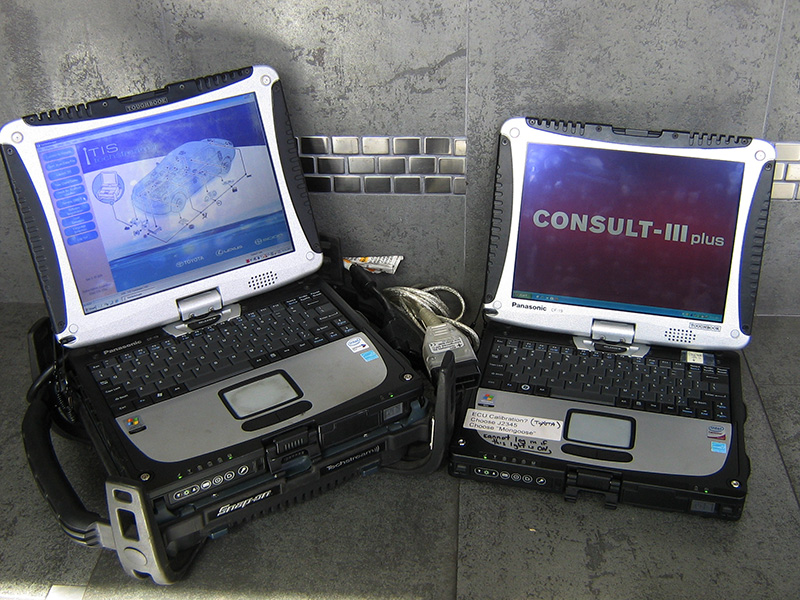
The Toyota TechStream can be purchased as a rugged, heavy-use laptop. If you have an existing laptop, you can purchase the Techstream Lite for use on it. Pictured here is the Nissan CONSULT-III, with Plus software and Techstream Lite installed. The clear OBD II connector between the two laptops is the Toyota Techstream Lite. Both Laptops feature capacitive touch screens that work without a special pen.
Training
If you’re going to work on Asian cars, you should invest in training and seminars to help identify pattern problems. We get a lot of cars from other shops with symptoms that are obvious to us, but those shops have replaced the common failure items on non-Asian cars: new fuel pump and filter, but the car still cranks and doesn’t start. We know from training and experience that it’s more than likely a bad EFI main relay or primary ignition part, not the fuel pump. What might work for domestic or European cars with the same symptom won’t necessarily fix Asian cars. Proper training will save you time, comebacks, and wasteful part installations. Investing in training will help avoid years of hard work doing “in-house†trial and error, replacing the wrong parts, and maybe even losing long-term customers.
Use training seminars to get familiar with the operation of hybrid vehicles as well. A large portion of the Asian market share is in hybrids. If you see a lot of Priuses in your area, think of all the possible work you could be performing if you’re familiar and equipped to handle Toyota’s most popular hybrid. Then, of course, there are all the other hybrids from Lexus, Honda, Nissan, etc. Training sessions will get you and your techs accustomed to the hybrid drivetrain and will remove the mystique surrounding these cars. They may be different, but they aren’t impossible for an independent to work on by any means!
Keeping current with training can make sure your shop stays aware of the manufacturers’ changing recommendations. Without being aware that many manufactures are shifting to synthetic oil, a routine oil change could cause severe engine damage, invalidate the customer’s warranty, and your shop could be on the hook for a whole new motor! Synthetic oils make the service a whole lot more expensive than you might quickly estimate on the phone. If you know the European or domestic market, think of taking on the Asian market by learning a new language, one that more and more customers are speaking as Japanese and Korean vehicles increase in popularity. Gear up your shop properly, and you won’t have to turn away lots of potential new business.

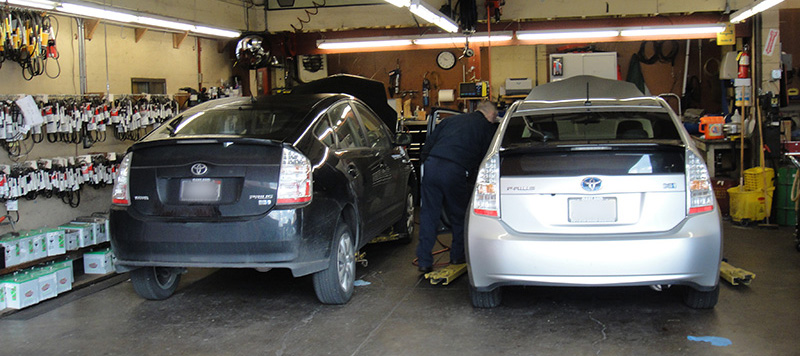



0 Comments